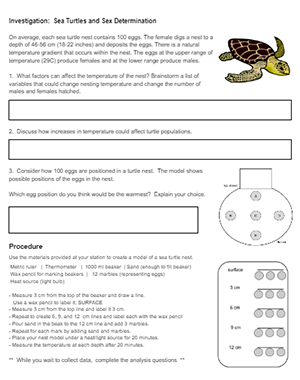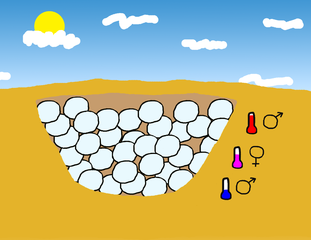
Unlike humans, turtles hatch as either male of temperature based on the temperature of the nest. A helpful mnemonic is “hot chicks and cool dudes.” Eggs that incubate at 28 degrees Celsius or above will hatch female turtles. Cooler eggs will hatch male turtles. This phenomenon is known as “temperature dependent sex determination” or TSD.
In this activity, students create a model of a turtle nest using a beaker and sand. Marbles represent eggs at different depths in the nest. Students use thermometers to measure the temperature at each depth.
Since it will take some time to warm the “nests” with a heat lamp, students can continue to the analysis section. This section includes questions related to the introduction. In addition, a graph shows how nest temperature can be altered with covers, like sheets, or palm leaves.
Students can also explore the primary research which reveals that covers can lower the nest temperature. I like to share article abstracts with students to improve their scientific literacy. Excerpt from abstract:
“Increasing incubation temperatures may threaten the viability of sea turtle populations. We explored opportunities for decreasing incubation temperatures at a Caribbean rookery with extreme female-biased hatchling production. To investigate the effect of artificial shading, temperatures were measured under simple materials (white sheet, white sand, palm leaves). “
“Increasing incubation temperatures may threaten the viability of sea turtle populations. We explored opportunities for decreasing incubation temperatures at a Caribbean rookery with extreme female-biased hatchling production. To investigate the effect of artificial shading, temperatures were measured under simple materials (white sheet, white sand, palm leaves). “
Esteban, N., Laloë, JO., Kiggen, F.S.P.L. et al. Optimism for mitigation of climate warming impacts for sea turtles through nest shading and relocation. Sci Rep 8, 17625 (2018). https://doi.org/10.1038/s41598-018-35821-6
Students can explore another data set of turtles in temperature with this CER (Claim, Evidence, Reasoning): Sexing Turtles – Hot Chicks and Cool Dudes. In this activity, students examine nest data from two sites in Australia.
Students in advanced classes, can also do an activity that explores survivorship curves in Loggerhead turtles. In this case study, students graph data on the number or turtles that survive. The population model shows that turtles are R-strategists. This means that more turtles hatch than survive, and that turtles have no parental care. Basically, they are on their own!


